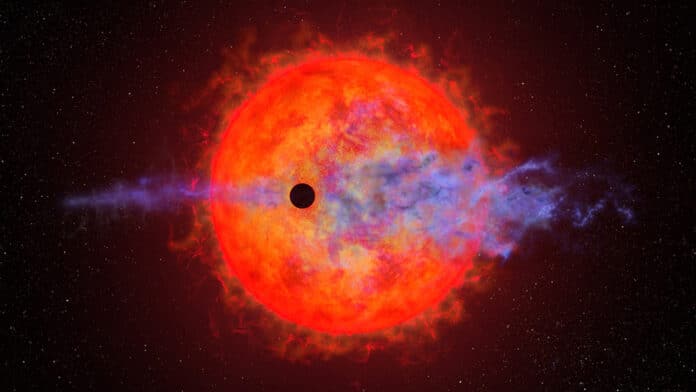Photoevaporation is a potential explanation for several features within exoplanet demographics. Atmospheric escape observed in young Neptune-sized exoplanets can provide insight into and characterize which mechanisms drive this evolution and at what times they dominate. AU Mic b is one such exoplanet.
Slightly larger than Neptune, the planet AU Mic b orbits its red dwarf star AU Microscopii (AU Mic), 32 light-years from Earth. It has an orbital period of 8.46 days and is just 6 million miles from the star.
It is believed that its proximity to its star causes it to experience a consistent, torrential blast of energy, which evaporates its hydrogen atmosphere – causing it to puff off the planet.
Recent observations from the Hubble Space Telescope indicate that the planet is changing in unpredictable ways orbit-by-orbit. It looks like the planet was not losing any material, whereas an orbit observed with Hubble a year and a half later showed clear signs of atmospheric loss.
This extreme variability between orbits shocked astronomers as they had never seen atmospheric escape go from completely not detectable to very detectable over such a short period when a planet passes in front of its star.
The quick and dramatic fluctuation in the host red dwarf’s outbursts may be indicated by the hitherto unseen shifts in the atmospheric outflow from AU Mic b. The star’s numerous turbulent magnetic field lines are the reason why there is so much variability. One theory for the absence of hydrogen during one of the planet’s transits is that a strong star flare observed seven hours earlier may have photoionized the hydrogen fleeing to the point where it became transparent to light and therefore was not visible.
Another theory is that the stellar wind shapes the planetary outflow, which is why it is sometimes visible. Some outflow may even “hiccup” ahead of the planet itself. Some models expect this will happen.
But this is the first kind of observational evidence of it happening and to such an extreme degree.
Keighley Rockcliffe of Dartmouth College in Hanover, New Hampshire, said, “We were expecting something predictable, repeatable. But it turned out to be weird. When I first saw this, I thought, ‘That can’t be right.'”
“I was equally puzzled to see, when it was detectable, the planet’s atmosphere puffing out in front of the planet, like a headlight on a fast-bound train.”
“This strange observation is a stress-test case for the modeling and the physics of planetary evolution. This observation is so cool because we’re getting to probe this interplay between the star and the planet at the most extreme.”
Red dwarfs are the most abundant stars in our Milky Way galaxy. But can planets orbiting red dwarf stars hospitable to life?
The fact that young red dwarfs produce fierce stellar flares spewing forth withering radiation is a significant obstacle. Compared to stars like our Sun, this phase of tremendous activity lasts a lot longer.
Strong magnetic fields that become entangled in the stellar atmosphere’s turbulent motions drive the flares. The fields break and reattach when the tangling becomes too severe, releasing enormous amounts of 100–1,000 times more powerful energy than our Sun produces during its outbursts.
Under these extreme conditions, the greatest atmospheric escape should occur on planets that develop within the first 100 million years of the star’s birth. This could result in a planet losing all of its atmosphere.
Rockcliffe said, “We want to find out what kinds of planets can survive these environments. What will they finally look like when the star settles down? And would there be any chance of habitability eventually, or will they wind up just being scorched planets?”
“Do they eventually lose most of their atmospheres, and their surviving cores become super-Earths? We don’t know what those final compositions look like because we don’t have anything like that in our solar system.”
Hubble follow-up observations of more AU Mic b transits should offer additional clues to the star and planet’s odd variability, further testing scientific models of exoplanetary atmospheric escape and evolution.
Journal Reference:
- Keighley E. Rockcliffe, Elisabeth R. Newton et al. The Variable Detection of Atmospheric Escape around the Young, Hot Neptune AU Mic b. The Astronomical Journal. DOI: 10.3847/1538-3881/ace536
